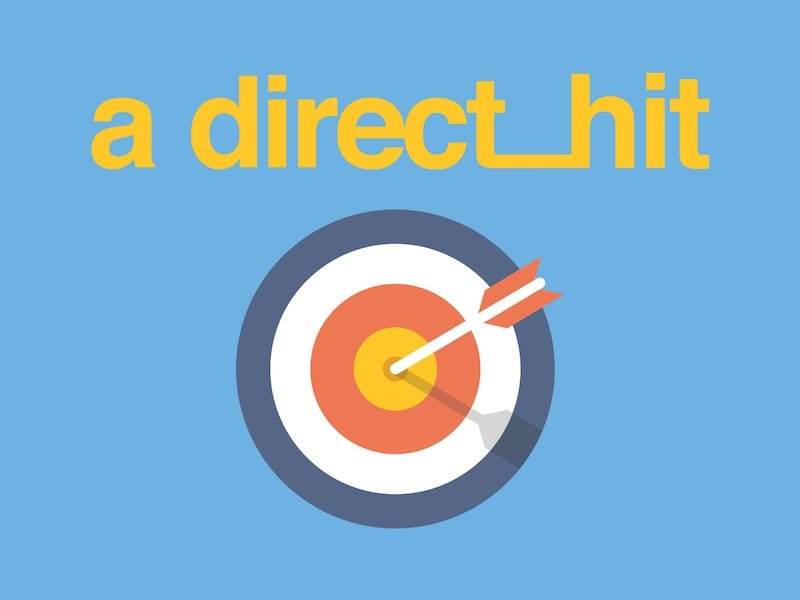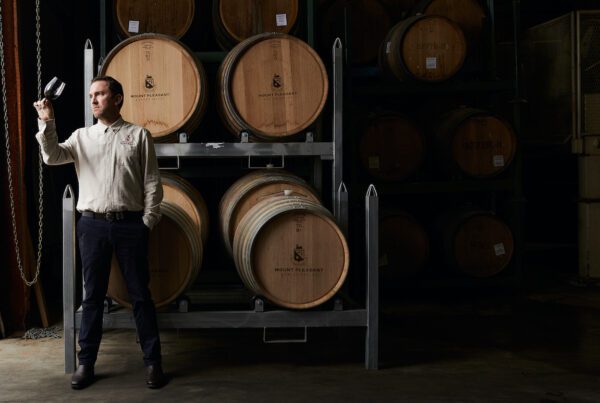
Direct marketing takes time and effort but done right, hits all the right places.
It’s not every day you sign up to a waiting list for a mailing list. That’s the reality for people wanting to get their hands on Noon Winery’s new releases. The majority of the McLaren Vale winery’s wine is sold direct to their 2000 mailing list customers. Unfortunately, that mailing list is fully subscribed.
From a small, family-run business point of view, it’s the perfect pickle to be in. Many small family wineries rely heavily on wine clubs and direct marketing to connect with customers. It’s not just about saying hello. The aim is to sell and avoid competing on liquor store shelves where discounting is fierce and destroying margins.
Noon doesn’t sell wine through their website and don’t produce enough to sell in quantity to trade. The 2015 reds and 2016 rosé won’t be found at restaurants (though small allocation is given to South Australia’s Salopian Inn, The Victory Hotel, and East End Cellars, Caulfield Cellars in Melbourne and Sydney’s Five Ways Cellars). Owners Drew and Raegan Noon retain just a little wine each release for general cellar door sales and open their doors for three consecutive weekends during November. That’s it.
“Most of it goes on the first day,” Drew says. “Normally speaking, people can get a six bottle mix pack but we sometimes reduce the limits to make sure there’s something available for the second and third weekend. It depends on the season.”
It’s reason enough for local fisherman Terry Rogers to circle 12 November in his calendar. “That’s the first day the cellar door opens,” he says. “I go early in the morning so I don’t miss out. I just want to be able to say I have it. I buy two bottles: one to drink and one to keep.”
Clever marketing? Great wine? Hype? A simple case of small batch supply versus demand?
“We’re lucky,” Drew says. “Mum and Dad only sold direct when they established the business in 1976. They had 20 years of just doing cellar doors. Back in those days people visited to stock their cellars. They built a really good following.”
Nowadays, a spot on Noon’s mailing list is generally only achievable when someone falls off the perch. It’s a nice place to be in, if you can establish such a devoted following.
“Your email list is like liquid gold,” Ideas Chick and digital marketing expert Mikyla Gilbert says. “It is the essence of how you build your relationship with customers in this digital age. Building up trust so that your potential customers get to know, like and trust you is incredibly powerful and if you can get people to hand over their email address you need to nurture that.”
Mikyla says it’s all about providing great value. “When people give you their email address, it’s like inviting you into their homes. It’s really important that you respect that and try to provide them with behind-the-scenes information, educate them, entertain them, and by doing that you can then build that trust and relationship with them to be able to sell them anything moving into the future.”
Different marketing methods work for different wineries. It’s about finding the best ones that suit you.
“If you do two things this year in direct marketing, it should be a) build your email list and b) improve your website,” Mikyla says. “When you are limited with budgets, which a lot of small wineries are, being able to talk directly to the inbox – directly to your customer – is probably the most valuable piece of marketing you have.”
It’s about authenticity. “Don’t ever buy lists. It doesn’t work. I’ve seen people try to send their product to another person’s winery list and no one gave them permission. They’re not interested.”
Done right, it can mean big business. “I know wineries that sell half their wine through one email a year. It’s more about the quality of the list than the number on the list. If you’ve only got 125 people on your list but 125 people buy your wine, rather than 1000 people on your list and five buy your wine. It’s not about the vanity metrics, it’s not about the number, it’s about the quality of that list and nurturing it.”
Matthew Barry, owner of Mount Avoca in Victoria’s Pyrenees Ranges, believes it is important to move with the times and look toward alternate markets. Mount Avoca put a stop to 4000 print newsletters and mail orders in the early nineties when the cost of printing, postage and labour made it redundant. “We used to make good sales but in the end it was costing us up to $8000 to send them out,” Matthew says. “We went from $40,000 worth of sales down to break even. What’s the point in that?”
The winery launched its Platinum Wine Club 10 years ago, and learnt that constant love and care is required to keep member numbers on the increase. “We’ve changed the format a bit so we’re giving people incredibly good deals.”
There’s no joining fee; instead, members commit to purchasing one case of wine, three times a year.
Benefits include all wine club cases at 50 percent off the online store price, delivery of one-dozen wines three times a year, access to limited releases and back-vintage wines, member discounts for wine dinners, 20 percent discount on any additional purchases, 15 percent discount on the property’s Eco-Luxe accommodation, and a complimentary glass of wine during cellar door visits.
If the wine is good, Matthew says people will commit. “We’re producing awesome wines that are getting 95 to 96 points year in, year out,” he says. “The small guys have to be exceptional. There’s so much wine out there and the big guys do incredibly well. When they want to put something out that’s top notch they have a lot of resources, money, expertise and a lot of wine. Because they’re so big, the prices are incredible, too. It’s hard to compete with those guys.”
Making great drops is just the beginning. Add market imbalance to the mix and wineries are in for challenging times. “You’ve got to be on the ball,” Matthew says. “You’ve got to look at ways of being different and ahead of the curve. For us, organic and alternative varieties is a point of difference. In a few more years, as more wineries do that and become organic, we’ve got to keep pushing the envelope to get better and better.”
South Australia’s Primo Estate did exactly that. “Five or six years ago, Joe Grilli was told ‘You’re insane, in five years you won’t have a business’ because he decided to pull out of the big box chains,” Catherine Woods, marketing manager at Primo Estate, says. “If you’re an independent wine seller you can’t compete with the big guys who can sell at a loss and buy the front page of every national paper.”
So, they decided to concentrate on owner Joe’s existing relationship with customers, their mailing list and cellar door. They also added a wine club to their offering and now have three: Primo Favourites Club, the JOSEPH Double Pruners Club, and the Virginia Vineyard Unlabelled Club. It means everyone is catered for. “We can’t do the same offer for someone who is buying a case of $90 wine as someone who is buying a case for $99,” Catherine says. “What we can do is something for each of them.”
Across the Vale, Oliver’s Taranga uses a mix of emails, phone campaigns, cellar door, snail mail newsletter and social media marketing to connect with customers, new and old. “We do phone campaigns because people like to get a direct contact,” winemaker and director Corrina Wright says. “But only once or twice a year at the max. We outsource this as we don’t have the skills inhouse.”
Emails notify subscribers about events in their state, new releases, sales and brand stories. “These drive the consistent sales throughout the year. This involves having a solid website.”
The company sends out a print newsletter twice a year. “We use snail mail because we still have some more traditional members on our list and they like to have some paper. This is a significant expense, but we use it to tell stories and reinforce our branding in a more ‘touchy feely’ way (with nice paper).” The company is also active on social media. “Because all the cool kids are doing it.”
If it sounds like a lot of work, it is.
“The hardest thing is keeping up with the new systems online and making sure we are at the top of the field (or as good as we can be),” Corrina says. “It’s hard when you are a small business and don’t have a dedicated team of internet professionals. Getting information from the right people and doing health checks are also important; simple things like making sure your website is readable on mobile is key.”
Oliver’s Taranga also launched their OTT wine club two years ago. Free freight was a winner with customers.
“Before we had free freight as standard, we used to do Free Freight Fridays every now and then and they would go mental. So much so that we called them “F#@king Free Freight Fridays, because they were packing nightmares.”
International wine club Oliver’s Wine Exchange is offered to customers in the US, Asia and Europe. “We started it because we finally were able to work with a decent freight forwarder who offered excellent service and door-to-door for our customers at slightly less ridiculous prices and turnaround times,” Corrina says. “Overseas cellar door pax are often keen to be able to access our wines at their homes, so we are now able to offer that. We don’t export much, so this fills a gap.”
Barossa Valley winery Yelland and Papps reached out to customers when setting up their Little Slice of Paradise rewards wine club. It launched in August and was a labour of love. Two-and-a-half years were spent listening to customer feedback.
“Funnily enough they didn’t want discounting,” tasting room manager Marty Powell says. “We’re able to respond to loyalty with access to premium products and experiences. It has actually created competition between some of our clients and generated more revenue.”
If you’re going to invest the time and energy into direct marketing, content is king. Louise Hemsley-Smith from Battle of Bosworth has a wine club and new website on the horizon and hopes to do a quality annual print newsletter when time permits. “I think it is important to have a dedicated marketing person, especially if you have a complex CRM system,” she says. “But this is a big commitment for a small family business.”
Be smart when using social media. “Spending money on Facebook and Instagram advertising is incredibly important,” Mikyla says. “Roughly 80 percent of people who like you on Facebook are never coming back to your Facebook page ever again, and only three percent of people who like your page are ever going to see your post in their newsfeed organically. So if you have 1000 followers on Facebook, you’ll only have 30 people seeing your post organically without you putting money behind it. Please don’t boost posts, it’s a waste of money. You need to do Facebook advertising.”
Use social media to drive qualified traffic to your website – it’s there that you pull them down your sales funnel, Mikyla says. “Get them to opt in for something, whether that’s a wine tasting checklist you provide for free, a wine tasting video they get access to, maybe they get to talk to you, or get a discount coupon, or a special release they can sign up for or an early bird [release], it’s really important you get them to opt in when they come to your website. It shouldn’t be an afterthought, it should be the number one priority.”
Social media can also be a great way to spread the word about winery events. For the team at SC Pannell, the announcement of a live performance by De La Soul, and a set by DJs Carl Cox and Eric Powell on 13 November, sent social media into a spin. “Without spending one marketing dollar, the Facebook event went viral,” Jason Nikolas, who works for the winery in sales, marketing and management, says. “The result being that it sold out in 24 hours. The fact is, an interesting story, and interesting niche events in the hands of the right people, will organically give you great marketing reach.”
Social media was also helpful when Steve Pannell released his 2013 Koomilya DC Block Shiraz and 2014 Koomilya Shiraz. “Given that a good majority of our top clientele are baby boomers, email marketing is still proving to be very effective, with high open and click through rates,” Jason says. “Social media is the trigger to bring it to people’s attention.”
Exclusive events can be rewarding, too. Wine dinners are a good way to attract new faces and reward club members. “We try to do two or three a year,” Matthew says. “Wine club members get priority and a discount. We combine with a restaurant and we both promote it. It’s fantastic because the value [for consumers] is incredible. We just try to cover our costs.”
The beauty is the personal insight into a brand. “We’ve created a following that enjoys direct access to our [Yelland and Papps] winemaker Michael and his wife Susan,” Marty says. “Hosting wine dinners is a great way to reinforce this and to show off our range. The family itself is a great marketing tool.”
Most wineries find that collection of email addresses is best done at events and at the cellar door. “We’ve found that the best quality data is from people who willingly surrender it and genuinely want to keep up the contact,” Marty says.
A bit of old school TLC doesn’t hurt, either. When Louise Rhodes, founder of Aphelion Wine, fulfills orders, handwritten notes accompany the bottles. She says it’s also beneficial to keep an eye on wineries you admire.
“As consumers we look forward to each Logan Wines mailout as well as Wendouree,” Louise says. “There is no rule book, so tackle your customer marketing the way and in the order that works best for you. Nothing is lost from experimentation.”
Above all, it’s about listening to customer needs. “When the opportunity arises and you’ve built up enough of a following, survey your audience and customers,” Jason says. “Listen, and give them what they want.”
And don’t underestimate the power of post. “Even though I’m a digital marketer, post is exciting as long as it is beautiful,” Mikyla says. “There is nothing better these days than going to the post box and getting something that is not a bill, isn’t junk mail or something from a politician. I would say the younger market get more of a buzz from getting something in the mail because all they get in the mail is online shopping.”
Direct marketing tips
(from Corrina Wright, Oliver’s Taranga)
- Talk in your real voice. Don’t pretend to be something you aren’t as people will see through you and you will go into the spam file.
- Less about pH and malolactic and oak, and more about the stories that make you/your brand/your story different.
- Make real connections and treasure them – people have trusted you with their details, don’t take the piss or waste their time or be annoying. Look after them with special, unexpected touches, like re-order dollars or little gifts or something nice.
- Always write personal notes when you send out orders.
- Make sure your website is top shelf in terms of usability, visibility and content.
- If you don’t know how to do something, ask people who are good at it and learn. Pay consultants that are good at what they do to assist you, but ultimately own it yourself.
- A website is never ‘done’ – it is constantly evolving, not static.
- Look at other industries – especially fashion – and copy the best.
Want to learn more?
Educate yourself. Podcasters out there specialise in online marketing. Amy Porterfield from Online Marketing Made Easy (America) is all about online businesses and building and nurturing your list. Pat Flynn’s Smart Passive Income blog and podcast is also worth a look.
A global issue
McLaren Vale winemaker Toby Bekkers was recently awarded a 2017 Nuffield Scholarship (supported by Wine Australia) to explore world best practice in the marketing of fine wines directly to consumers. The aim is to create an alternative distribution model to the highly competitive wholesale channel. Toby wants to understand the opportunities for small-to-medium-sized Australian wineries to access export markets using a direct-to-consumer sales and distribution model. nuffield.com.au
Just ask
“Don’t be afraid to ask for the email address,” Ideas Chick Mikyla Gilbert says. “Don’t just leave bits of paper at the cellar door or go to a function and just have a little sheet there and expect people to fill it out. Give them a reason to. Provide them with opportunities to go to special events, special lunches… find out what floats their boat. You need to understand your ideal customers. Not the customers you have but the customers you want.
Put it out on your Facebook page once or twice a week: ‘Did you know we have a great email list and this is what you’ll get? Click here to subscribe’. Don’t be afraid to put it out there and don’t be afraid to put some money behind that post. It should also be prominent on your website. Provide them with something that will attract them to join your mailing list. We call it a ‘lead magnet’ in the industry. I would suggest that could be a wine flight sheet you could print off and do at home, or a checklist on how to store wine. Something providing value, education or entertainment.”









Recent Comments